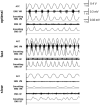The Effect of Pedaling at Different Cadence on Attentional Resources
- PMID: 35280213
- PMCID: PMC8913718
- DOI: 10.3389/fnhum.2022.819232
The Effect of Pedaling at Different Cadence on Attentional Resources
Abstract
We investigated the relationship between attentional resources and pedaling cadence using electroencephalography (EEG) to measure P300 amplitudes and latencies. Twenty-five healthy volunteers performed the oddball task while pedaling on a stationary bike or relaxing (i.e., no pedaling). We set them four conditions, namely, (1) performing only the oddball task (i.e., control), (2) performing the oddball task while pedaling at optimal cadence (i.e., optimal), (3) performing the oddball task while pedaling faster than optimal cadence (i.e., fast), and (4) performing the oddball task while pedaling slower than optimal cadence (i.e., slow). P300 amplitudes at Cz and Pz electrodes under optimal, fast, and slow conditions were significantly lower than those under control conditions. P300 amplitudes at Pz under fast and slow conditions were significantly lower than those under the optimal condition. No significant changes in P300 latency at any electrode were observed under any condition. Our findings revealed that pedaling at non-optimal cadence results in less attention being paid to external stimuli compared with pedaling at optimal cadence.
Keywords: P300; attention; electroencephalography; oddball paradigm; pedaling.
Copyright © 2022 Akaiwa, Iwata, Saito, Shibata, Sasaki and Sugawara.
Conflict of interest statement
The authors declare that the research was conducted in the absence of any commercial or financial relationships that could be construed as a potential conflict of interest.
Figures






Similar articles
-
Influence of education level on design-induced N170 and P300 components of event related potentials in the human brain.J Integr Neurosci. 2014 Mar;13(1):71-88. doi: 10.1142/S0219635214500058. Epub 2014 Mar 13. J Integr Neurosci. 2014. PMID: 24738540
-
Cognitive effects of rhythmic auditory stimulation in Parkinson's disease: A P300 study.Brain Res. 2019 Aug 1;1716:70-79. doi: 10.1016/j.brainres.2018.05.016. Epub 2018 May 16. Brain Res. 2019. PMID: 29777676
-
[Effect of mental fatigue induced by repeated continuous calculation tasks on event-related brain potential (P300)].Sangyo Eiseigaku Zasshi. 2007 Sep;49(5):203-8. doi: 10.1539/sangyoeisei.49.203. Sangyo Eiseigaku Zasshi. 2007. PMID: 17938559 Japanese.
-
[Cerebral inhibitory functioning in patients with attention deficit/hyperactivity disorder. I. Analysis of non-target-P300 component in a visual oddball paradigm].No To Hattatsu. 2007 Jul;39(4):263-7. No To Hattatsu. 2007. PMID: 17633082 Japanese.
-
Effects of complexity of visual distracters on attention and information processing speed reflected in auditory p300.Ear Hear. 2012 Jul-Aug;33(4):480-8. doi: 10.1097/AUD.0b013e3182446a42. Ear Hear. 2012. PMID: 22343547
Cited by
-
ERP evidence of attentional somatosensory processing and stimulus-response coupling under different hand and arm postures.Front Hum Neurosci. 2023 Nov 1;17:1252686. doi: 10.3389/fnhum.2023.1252686. eCollection 2023. Front Hum Neurosci. 2023. PMID: 38021238 Free PMC article.
-
Continuous peripersonal tracking accuracy is limited by the speed and phase of locomotion.Sci Rep. 2023 Sep 8;13(1):14864. doi: 10.1038/s41598-023-40655-y. Sci Rep. 2023. PMID: 37684285 Free PMC article.
-
EEG decoding for effects of visual joint attention training on ASD patients with interpretable and lightweight convolutional neural network.Cogn Neurodyn. 2024 Jun;18(3):947-960. doi: 10.1007/s11571-023-09947-x. Epub 2023 Mar 7. Cogn Neurodyn. 2024. PMID: 38826651 Free PMC article.
-
Event-Related Brain Potentials N140 and P300 during Somatosensory Go/NoGo Tasks Are Modulated by Movement Preparation.Brain Sci. 2023 Dec 30;14(1):38. doi: 10.3390/brainsci14010038. Brain Sci. 2023. PMID: 38248253 Free PMC article.
-
The brain in motion-cognitive effects of simultaneous motor activity.Front Integr Neurosci. 2023 May 25;17:1127310. doi: 10.3389/fnint.2023.1127310. eCollection 2023. Front Integr Neurosci. 2023. PMID: 37304529 Free PMC article. Review.
References
-
- Al-Yahya E., Dawes H., Smith L., Dennis A., Howells K., Cockburn J. (2011). Cognitive motor interference while walking: a systematic review and meta-analysis. Neurosci. Biobehav. Rev. 35 715–728. - PubMed
LinkOut - more resources
Full Text Sources
Miscellaneous

